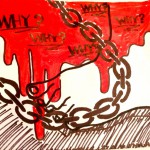On the final exam, as on the midterm exam, there will be two parts. In Part I, you will have a list of terms that we have learned this semester (review our list here, and get more background information from “Elements of Fiction.” There will also be a list of 10 passages from our readings since the midterm. You will have to choose five of the passages, and for each, you will identify the title and author of the passage, identify which term is an appropriate label for that passage, AND explain why in a sentence or two. There might be more than one term that applies to any given passage, for example, if a passage is an example of first-person narration and setting–either would be correct in that case. You will not get credit, though, if you do not provide an explanation of why it is the appropriate label, since I won’t know if you know the terms or are just guessing. In completing Part I, you will need to use five different terms–that is, each term you use cannot be used more than once, even if they can apply to more than one passage. Extra credit will be given for completing a sixth answer.
In Part II, you will write a well-developed essay(thesis-driven, organized, thoughtful, evidence-based, proofread), in which you compare two texts we have read since the midterm exam based on their approach to one of the following issues, topics, or themes. Use two examples from each story, using quotations from your quotation sheet as evidence, developed using the now-famous five-step method, to support for your thesis-driven essay. If you want to include a third story as well, you can, and that can include anything we read this semester, but make sure you have enough time to do so. Here are the five questions we agreed upon:
- Using two stories we read, compare what happens when characters face impossible choices.
- Using two stories we read, compare what happens when stories are not definitive but instead create uncertainty or ambiguity or a multiplicity of possibility when important information is the unknowable or un-confirmable.
- Using two stories we read, compare how characters’ personal history or family history have an impact on future generations.
- Using two stories we read, compare what happens when characters exhibit pride. Consider the positive and/or negative effects of pride.
- Using two stories we read, compare what happens when characters reverse roles, including familial, professional, or social roles.
Look back at our class notes as we brainstormed these topics for the ideas we discussed in class. On the exam, this will be a list of three, so be sure to prepare three of the five to guarantee one of your preferred options will be available to you on Monday! Look for the poll in the sidebar to give me a sense of which question you’re hoping to find on the exam on Monday.
Your essay should be approximately 500-600 words—if you’re writing 5 words per line, that’s 5-6 pages in the blue book, fewer pages if you get more words per line. There’s no need to count all of the words: check to see roughly how many words you write per line on a few lines, then multiply that by 20 (lines per page) and the number of pages you have. Most of you had no trouble meeting this requirement this for the midterm exam. When you include a quotation, even though it is already on your quotation sheet, I ask that you copy it into your essay. Rather than using whiteout or making a mess, when you need to make a correction, just cross out what you want to delete.
To get started, you should use the time before the exam to plan your three possible essays. Take time at the start of the exam to think about which question you will respond to, remember what you want to write about it, and use the blue book to write down notes before you start writing the essay. There’s no need to skip every other line, but you might want to skip a line or two between paragraphs to give yourself space to add in any additional words or sentences when you re-read your essay.






